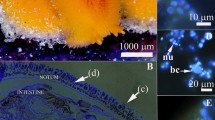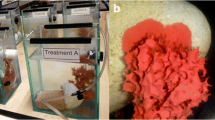Abstract
Sponges (Porifera) are filter feeders that take up microorganisms from seawater and digest them by phagocytosis. At the same time, many sponges are known to harbor massive consortia of symbiotic microorganisms, which are phylogenetically distinct from those in seawater, within the mesohyl matrix. In the present study, feeding experiments were performed to investigate whether phylogenetically different bacterial isolates, hereafter termed “food bacteria,” microbial seawater consortia, and sponge symbiont consortia are taken up and processed differently by the host sponge. Aplysina aerophoba retained high numbers of bacterial isolates and microbial seawater consortia with rates of up to 2.76 × 106 bacteria (g sponge wet weight)–1 h–1, whereas the retention of sponge symbionts was lower by nearly two orders of magnitude [5.37 × 104 bacteria (g sponge wet weight)−1 h–1]. In order to visualize the processing of a food bacterium within sponge tissues, the green fluorescent protein-labeled Vibrio strain MMW1, which had originally been isolated from A. aerophoba, was constructed. Incubation of this strain with A. aerophoba and subsequent visualization in tissue cryosections showed its presence in the choanocytes and/or endopinacocytes lining the canals but, unlike latex beads, not in deeper regions of the mesohyl, which suggests digestion of the bacteria upon contact with the host. Denaturing gradient gel electrophoresis (DGGE) was performed on the incubation seawater to monitor the changes in phylogenetic composition after incubation of the sponge with either seawater or sponge symbiont consortia. However, the DGGE experiment provided no evidence for selective processing of individual lineages by the host sponge. In conclusion, this study extends early studies by Wilkinson et al. (Proc R Soc London B 220:519–528, 1984) that sponges, here A. aerophoba, are able to differentiate between food bacteria and their own bacterial symbionts.





Similar content being viewed by others
References
Ausubel, FM, Brent, R, Kingston, RE, Moore, DD, Seidman, JG, Smith, JA, Struhl K (Eds.) (2003) Preparation of genomic DNA from bacteria. In: Current Protocols in Molecular Biology, vol. 1. John Wiley and Sons, Inc, New York, Chap. 4.2
Bell, AH, Bergquist, PR, Battershill, CN (1999) Feeding biology of Polymastia croceus. Mem Queensland Mus 44: 51–56
Celli, J, Finlay, BB (2002) Bacterial avoidance of phagocytosis. Trends Microbiol 10: 232–237
de Bary HA (1879) Die Erscheinung der Symbiose. In: Trübner, KJ (Ed.) Versammlung deutscher Naturforscher und Ärzte zu Cassel. Trübner, Strassburg
Ducklow, H (2000) Bacterial production and biomass in the oceans. In: Kirchman, DL (Eds.) Microbial Ecology of the Oceans. Wiley, New York, pp 85–120
Fieseler L (2005) Entdeckung des neuen Candidatus Phylums Poribacteria. PhD thesis, Universität Würzburg, Germany
Fieseler, L, Horn, M, Wagner, M, Hentschel, U (2004) Discovery of a novel candidate phylum ‘Poribacteria’ in marine sponges. Appl Environ Microbiol 70: 3724–3732
Fieseler, L, Quaiser, A, Schleper, C, Hentschel, U (2006) Analysis of the first genome fragment from the marine sponge-associated, novel candidate phylum Poribacteria by environmental genomics. Environ Microbiol 8: 612–624
Friedrich, AB, Fischer, I, Proksch, P, Hacker, J, Hentschel, U (2001) Temporal variation of the microbial community associated with the Mediterranean sponge Aplysina aerophoba. FEMS Microbiol Ecol 38: 105–113
Hagstrom, A, Pommier, T, Rohwer, F, Simu, K, Stolte, W, Svensson, D, Zweifel, UL (2002) Use of 16S ribosomal DNA for delineation of marine bacterioplankton species. Appl Environ Microbiol 68: 3628–3633
Hentschel, U, Usher, KM, Taylor, MW (2006) Marine sponges as microbial fermenters. FEMS Microb Ecol 55: 167–177
Hentschel, U, Schmid, M, Wagner, M, Fieseler, L, Gernert, C, Hacker, J (2001) Isolation and phylogenetic analysis of bacteria with antimicrobial activities from the Mediterranean sponge Aplysina aerophoba and Aplysina cavernicola. FEMS Microbiol Ecol 35: 305–312
Hentschel, U, Fieseler, L, Wehrl, M, Gernert, C, Steinert, M, Hacker, J, Horn, M (2003) Microbial diversity of marine sponges. In: Müller, WEG (Ed.) Molecular Marine Biology of Sponges. Springer, Heidelberg, pp 59–88
Hentschel, U, Hopke, J, Horn, M, Friedrich, AB, Wagner, M, Hacker, J, Moore, BS (2002) Molecular evidence for a uniform microbial community in sponges from different oceans. Appl Environ Microbiol 68: 4431–4440
Heuner, K, Steinert, M (2003) The flagellum of Legionella pneumophila and its link to the expression of the virulent phenotype. Int J Med Microbiol 293: 133–143
Hill, RT (2004) Microbes from marine sponges: a treasure trove of biodiversity for natural products discovery. In: Bull, AT (Ed.) Microbial Diversity and Bioprospecting. ASM Press, Washington, DC, pp 177–190
Imhoff, JF, Stöhr, R (2003) Sponge-associated bacteria: general overview and special aspects of bacteria associated with Halichondria panicea. In: Müller, WEG (Ed.) Molecular Marine Biology of Sponges. Springer, Heidelberg, pp 35–57
Milanese, M, Chelossi, E, Manconi, R, Sara, A, Sidri, M, Pronzato, R (2003) The marine sponge Chondrilla nucula Schmidt, 1862 as an elective candidate for bioremediation in integrated aquaculture. Biomol Eng 20: 363–368
Millikan, DS, Ruby, EG (2002) Alterations in Vibrio fischeri motility correlate with a delay in symbiosis initiation and are associated with additional symbiotic colonization defects. Appl Environ Microbiol 68: 2519–2528
Muyzer, G, Brinkhoff, T, Nübel, U, Santegoeds, C, Schäfer, H, Wawer, C (1998) Denaturing gradient gel electrophoresis (DGGE) in microbial ecology. Mol Microb Ecol 3.4.4: 1–27
Pile, AJ (1997) Finding Reiswig's missing carbon: quantification of sponge feeding using dual-beam flow cytometry. Proc Int Coral Reef Symp 2: 1403–1410
Pile, AJ, Patterson, MR, Witman, JD (1996) In situ grazing on plankton <10 μm by the boreal sponge Mycale lingua. Mar Ecol Prog Ser 141: 95–102
Pile, AJ, Grant, A, Hinde, R, Borowitzka, MA (2003) Heterotrophy on ultraplankton communities is an important source of nitrogen for a sponge–rhodophyte symbiosis. J Exp Biol 206: 4533–4538
Pimentel-Elardo, S, Wehrl, M, Friedrich, AB, Jensen, PR, Hentschel, U (2003) Isolation of planctomycetes from Aplysina sponges. Aquat Microb Ecol 33: 239–245
Price, NP (1999) Carbohydrate determinants of Rhizobium–legume symbioses. Carbohydr Res 317: 1–9
Reiswig, HM (1971) Particle feeding in natural populations of three marine demosponges. Biol Bull 141: 568–226
Reiswig, HM (1974) Water transport, respiration and energetics of three tropical marine sponges. J Exp Mar Biol Ecol 14: 231–249
Reiswig, HM (1975) Bacteria as food for temperate-water marine sponges. Can J Zool 53: 582–589
Ribes, M, Coma, R, Gili, JM (1999) Natural diet and grazing rate of the temperate sponge Dysidea avara (Demospongiae, Dendroceratida) throughout an annual cycle. Mar Ecol Prog Ser 176: 179–190
Rottmann, M, Schröder, HC, Gramzow, M, Renneisen, K, Kurelec, B, Dorn, A, Friese, U, Müller, WEG (1987) Specific phosphorylation of proteins in pore complex-laminae from the sponge Geodia cydonium by the homologous aggregation factor and phorbol ester. Role of the protein kinase C in the phosphorylation of DNA topoisomerase II. EMBO J 6: 3939–3944
Scheuermayer, M, Pimentel-Elardo, S, Fieseler, L, Grozdanov, L, Hentschel, U (2006) Microorganisms of sponges: phylogenetic diversity and biotechnological potential. In: Proksch, P, Müller, WEG (Eds.) Biotechnology of Marine Natural Products. Horizon Scientific, UK, pp 289–312
Teeyapant, R, Woerdenbag, HJ, Kreis, P, Hacker, J, Wray, V, Witte, L, Proksch, P (1993) Antibiotic and cytotoxic activity of brominated compounds from the marine sponge Verongia aerophoba. Z Naturforsch [C] 48: 939–945
Thiel, V, Imhoff, JF (2003) Phylogenetic identification of bacteria with antimicrobial activities isolated from Mediterranean sponges. Biomol Eng 20: 421–423
Thoms, C, Horn, M, Wagner, M, Hentschel, U, Proksch, P (2003) Monitoring microbial diversity and natural products profiles of the sponge Aplysina cavernicola following transplantation. Mar Biol 142: 685–692
Turon, X, Galera, J, Uriz, MJ (1997) Clearance rates and aquiferous systems in two sponges with contrasting life-history strategies. J Exp Zool 278: 22–36
Vacelet, J, Donadey, C (1977) Electron microscope study of the association between some sponges and bacteria. J Exp Mar Ecol 30: 301–314
Venter, JC, Remington, K, Heidelberg, JF, Halpern, AL, Rusch, D, Eisen, JA, Wu, D, Paulsen, I, Nelson, KE, Nelson, W, Fouts, DE, Levy, S, Knap, AH, Lomas, MW, Nealson, K, White, O, Peterson, J, Hoffman, J, Parsons, R, Baden-Tillson, H, Pfannkoch, C, Rogers YH, Smith, HO (2004) Environmental genome shotgun sequencing of the Sargasso Sea. Science 304: 66–74
Wadstrom, T, Ljungh, A (1999) Glycosaminoglycan-binding microbial proteins in tissue adhesion and invasion: key events in microbial pathogenicity. J Med Microbiol 48: 223–233
Webster N, Hill RT (2001) The culturable microbial community of the Great Barrier Reef sponge Rhopaloeides odorabile is dominated by an α–proteobacterium. Mar Biol 138: 843–851
Wehrl, M (2001) Untersuchungen zur Interaktion des marinen Schwammes A. aerophoba mit assoziierten Mikroorganismen. Masters thesis, Universität Würzburg, Germany
Wilkinson CR, Garrone G, Vacelet J (1984) Marine sponges discriminate between food bacteria and bacterial symbionts: electron microscope radioautography and in situ evidence. Proc R Soc London B 220: 519–528
Wilkinson, CR, Nowak, M, Austin, B, Colwell, RR (1981) Specificity of bacterial symbionts in Mediterranean and Great Barrier Reef Sponges. Microb Ecol 7: 13–21
Acknowledgments
We gratefully acknowledge the marine operations personnel at the Laboratoire Arago for help during sponge collection and H. Moreau for sharing laboratory space and equipment (Banyuls-sur-Mer, France). We thank S. Schmitt for laboratory assistance and valuable discussions, E. Strom for mathematical support, K. Heuner for help with the construction of the GFP-labeled Vibrio strain MMW1 (all University of Würzburg), and D. Millikan (University of Hawaii) for the supply of Vibrio flagellar mutants. Financial support for this work was provided by the SFB567 to U. Hentschel and M. Steinert.
Author information
Authors and Affiliations
Corresponding author
Rights and permissions
About this article
Cite this article
Wehrl, M., Steinert, M. & Hentschel, U. Bacterial Uptake by the Marine Sponge Aplysina aerophoba . Microb Ecol 53, 355–365 (2007). https://doi.org/10.1007/s00248-006-9090-4
Received:
Accepted:
Published:
Issue Date:
DOI: https://doi.org/10.1007/s00248-006-9090-4




